Themed collection Crystal Engineering in Africa

Crystal engineering in Africa
Susan A. Bourne, Delia A. Haynes and Patrice Kenfack Tsobnang introduce the CrystEngComm themed collection “Crystal engineering in Africa”.

CrystEngComm, 2024,26, 8-10
https://doi.org/10.1039/D3CE90156D
Selectivity of hosts for guests by liquid-assisted grinding: differences between solution and mechanochemistry
Selectivity profiles obtained mechanochemically differ from those obtained in solution, both for selectivity during crystallisation and selectivity by guest exchange.
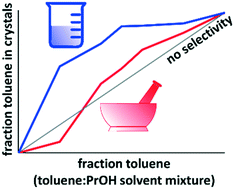
CrystEngComm, 2021,23, 7380-7384
https://doi.org/10.1039/D1CE01286J
The design of a series of cocrystals featuring dicarboxylic acid with a modified isoniazid derivative
Five cocrystals featuring a modified isoniazid derivative (N′-(propan-2-ylidene)pyridine-4-carbohydrazide) with aliphatic dicarboxylic acids with varying chain lengths was synthesized and characterized.

CrystEngComm, 2024,26, 268-276
https://doi.org/10.1039/D3CE00846K
The odd–even effect in n-carboxyalkylammonium-containing organic–inorganic hybrids of Mn(II) halides: structural and magnetic characterisation
The combination of n-carboxyalkylamines with MnCl2 in HCl yields 0D compounds of the formula (NH3(CH2)nCOOH)2[MnCl4(H2O)2] when n = 2 or 4, and 2D halide perovskites of the formula (NH3(CH2)nCOOH)2[MnCl4] when n = 3 or 5.

CrystEngComm, 2023,25, 6568-6591
https://doi.org/10.1039/D3CE00855J
Crystal engineering of a new pharmaceutical polymorph of gallic acid monohydrate: a structural comparative study and chemical computational quantum investigations
Exploiting new polymorphs of active pharmaceutical ingredients (APIs) has a significant role in the development of new processes for the pharmaceutical industry.
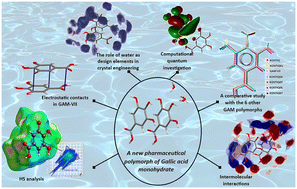
CrystEngComm, 2023,25, 6279-6290
https://doi.org/10.1039/D3CE00766A
Crystallisation of organic hydrates by sublimation
Hydrates of organic molecules can be crystallised by sublimation if there is a strong hydrogen bond to water in the solid hydrate.

CrystEngComm, 2023,25, 5887-5892
https://doi.org/10.1039/D3CE00732D
Forced topochemistry of a solid-state Diels–Alder reaction by encapsulation in epoxy glue
Encapsulation of unreacted crystals with epoxy glue forced a topotactic reaction to occur topochemically until ∼89% conversion which led to more reaction details being exposed.
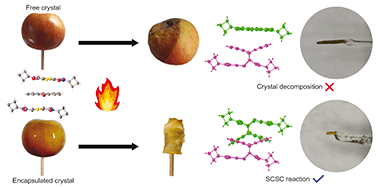
CrystEngComm, 2023,25, 3988-3997
https://doi.org/10.1039/D3CE00388D
Synthesis, crystal structures and DFT studies of Co(II) and Zn(II) coordination polymers of terephthalate and 4,4′-trimethylenedipyridyl ligands for removal of dibenzothiophene from a model fuel oil
Removal of sulfur-containing compounds was necessitated by the negative environmental and human health challenges posed by sulfur oxides that are released into the atmosphere upon combustion of sulfur-containing fuel oils.
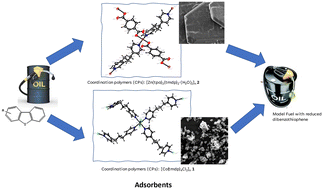
CrystEngComm, 2023,25, 3998-4010
https://doi.org/10.1039/D3CE00236E
Synthesis, structure diversity, and antimicrobial studies of Ag(I) complexes with quinoline-type ligands
Self-assembled [Ag(5NO2Qu)2]BF4 and [Ag(Qu3CN)(H2O)]BF4 were analysed with Hirshfeld surfaces and tested for antimicrobial properties.

CrystEngComm, 2023,25, 3922-3930
https://doi.org/10.1039/D3CE00417A
Host behaviour of two tricyclic fused systems in mixed anisole guest solvents
N,N′-Bis(5-phenyl-5-dibenzo[a,d]cycloheptenyl)ethylenediamine H1 possessed a remarkable affinity for 4-MA due to significantly shorter intermolecular host⋯host C–H⋯π and π⋯π (the stereoview here) interactions in H1·4MA compared with in H1·3MA.

CrystEngComm, 2023,25, 3013-3024
https://doi.org/10.1039/D3CE00174A
Complementary host behaviour of three anthracenyl-derived roof-shaped compounds in mixed pyridines
Three roof-shaped host compounds possessed complementary selectivity behaviour in mixed pyridines. This stereoview shows the inclusion of a pair of guest molecules by six host molecules in H3·2MePy. (Guest carbon atoms are in black for contrast).

CrystEngComm, 2023,25, 1740-1754
https://doi.org/10.1039/D3CE00080J
An investigation of the selectivity behaviour of host compound (R,R)-(−)-2,3-dimethoxy-1,1,4,4-tetraphenylbutane-1,4-diol in mixed cresols
(R,R)-(−)-2,3-Dimethoxy-1,1,4,4-tetraphenylbutane-1,4-diol (H2) retains 2-cresol (2Cr) in the 2(H2)·2Cr complex by means of a unique (guest)O–H⋯π(host) interaction.

CrystEngComm, 2023,25, 1731-1739
https://doi.org/10.1039/D3CE00101F
Tuning the topology of a 2D metal–organic framework from 2D to 3D using modulator assisted synthesis
Two novel metal–organic frameworks are isolated from solvothermal conditions. By introducing a modulator, the 2D MSU-10 MOF could be transformed into a 3D network with a rare topology.

CrystEngComm, 2023,25, 1486-1494
https://doi.org/10.1039/D3CE00039G
Synthesis, structure and magnetic properties of two bis(oxalato)cuprate(II) salts with pyridinium type counter ions
In the Cu(II) oxalate salts of (C5H7N2O)2[Cu(C2O4)2] 1 and C13H16N2[Cu(C2O4)2] 2, the oxalate adopts different coordination modes: the common bidentate chelating oxalate in 1 and the relatively scarce μ-oxalato-κ3O1,O2:O1′ in 2.
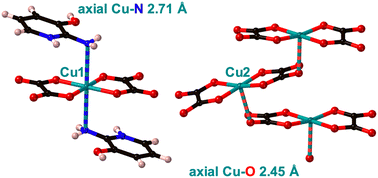
CrystEngComm, 2023,25, 1479-1485
https://doi.org/10.1039/D2CE01513G
Excitation dependent white and red-NIR emission of a MnII-based complex
The emission from the (AmpH)2[MnCl4(Amp)2] can be changed from white to red-NIR by excitation wavelengths variation. The red phosphorescence originates from the MnII octahedral ions, while the NIR-fluorescence is assigned to the [C5H8N3]+ cation.
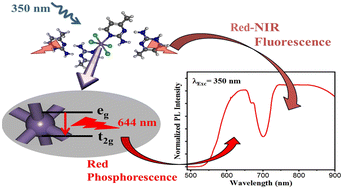
CrystEngComm, 2022,24, 8467-8476
https://doi.org/10.1039/D2CE01138G
Design of coordination polymers based on combinations of 1,2-diphenylethane-1,2-diyl diisonicotinate with Cu(II), Zn(II), Cd(II) and Co(II)
Five new supramolecular coordination polymers of different dimensionalities (L-Cu(acac)2, L-Cu(hfac)2, L-ZnCl2, L-CdI2 and L-CoCl2) based on the use of the flexible organic ligand L (1,2-diphenylethane-1,2-diyl diisonicotinate) are reported.

CrystEngComm, 2022,24, 7632-7639
https://doi.org/10.1039/D2CE01001A
Effective role of Rb doping in controlling the crystallization, crystal imperfections, and microstructural and morphological features of ZnO-NPs synthesized by the sol–gel approach
This article is allocated to synthesizing pure ZnO and Rb-doped ZnO nanoparticles, RbxZn1−xO-NPs via the sol–gel technique and then studying the effect of Rb doping ZnO on the crystal structure, microstructure parameters and morphology of the host lattice.
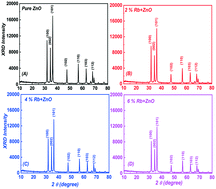
CrystEngComm, 2022,24, 4661-4678
https://doi.org/10.1039/D2CE00483F
Topological motifs in dicyanamides of transition metals
Topological analysis of all known dicyanamides (dca) of metal ions was carried out. Regularities observed were applied in the design of five novel compounds.
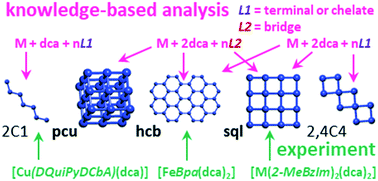
CrystEngComm, 2022,24, 4740-4747
https://doi.org/10.1039/D2CE00485B
Structural transitions during the water sorption process in two layered metal hydrogen-bonded organic frameworks and the effect of the H-bond strength between the layers
The strength of the interactions between the layers of 2D porous materials defines the characteristics of their sorption isotherms.

CrystEngComm, 2022,24, 3338-3346
https://doi.org/10.1039/D2CE00138A
Influence of foreign salts on the CaCO3 pre-nucleation stage: application of the conductometric method
Electrical conductivity modeling applied to the fast controlled precipitation method data is used to underline the existence of different ion pairs during the prenucleation stage as a function of the foreign salts NaCl, MgCl2, Na2SO4 and MgSO4.

CrystEngComm, 2022,24, 3256-3267
https://doi.org/10.1039/D2CE00099G
Solvatochromism and the effect of solvent on properties in a two-dimensional coordination polymer of cobalt-trimesate
A 2D coordination polymer can exchange guest species from liquid sorption, with accompanying visible colour changes.

CrystEngComm, 2022,24, 2393-2401
https://doi.org/10.1039/D2CE00039C
Effect of the growth pulling direction on 3D anisotropic stress during different stages of semitransparent Li2MoO4 growth
The three dimensional thermal stress field was calculated for different growth stages of a Li2MoO4 (LMO) crystal grown in an inductively heated Czochralski furnace using the anisotropy and temperature-dependent mechanical properties.
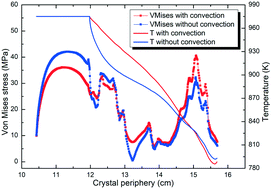
CrystEngComm, 2021,23, 8612-8621
https://doi.org/10.1039/D1CE00766A
Crystalline Cu(II) metal–organic frameworks based on a carboxamide pincer ligand and an NCONCON–Pd(II) pincer complex
Two copper MOFs based on carboxamide linkers are presented. This work shows how organometallic complexes with carboxylate functionalities can be repurposed to produce crystalline MOFs which can be used in carbon dioxide conversion.
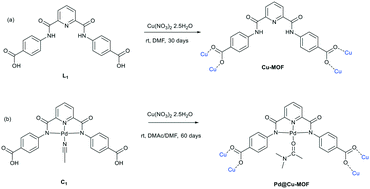
CrystEngComm, 2021,23, 7418-7424
https://doi.org/10.1039/D1CE00999K
Morphogenesis mechanisms in the hydrothermal growth of lead-free BCZT nanostructured multipods
The nanostructuring approach may offer a new route to tailor lead-free ferroelectrics with superior energy storage performance for ceramic actuators and capacitors.
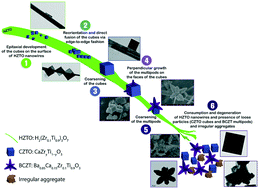
CrystEngComm, 2021,23, 5249-5256
https://doi.org/10.1039/D1CE00591J
Characterization of defect levels in β-Ga2O3 single crystals doped with tantalum
Optical properties and defect characterization of Ta-doped β-Ga2O3 single crystals grown by the optical floating zone method.

CrystEngComm, 2021,23, 2835-2841
https://doi.org/10.1039/D0CE01639J
Relationship between structural and dielectric properties of Zn-substituted Ba5CaTi2−xZnxNb8O30 tetragonal tungsten bronze
Ba5CaTi2−xZnxNb8O30 ceramics (x = 0, 0.04, and 0.08) were synthesized by a conventional solid-state reaction method at 1300 °C for 6 hours.

CrystEngComm, 2021,23, 163-173
https://doi.org/10.1039/D0CE01561J
About this collection
This special collection celebrates the diversity and excellence of research in crystal engineering being carried out across Africa.
2023 has been a momentous year for crystallography in Africa. This year, the African Crystallographic Association (AfCA) was approved as the fifth regional associate of the International Union of Crystallography (IUCr). This is a sound indicator of how far crystallography has developed on the African continent in recent years. There is a strong tradition of crystallography in Africa, but historically this was focused in the far North and the far South. Over the past decade, there has been a significant drive to increase crystallographic education and practice across the continent. Student development, schools and workshops, conferences, and many other activities have been strongly supported by the crystallography community worldwide. The International Year of Crystallography in 2014 provided the impetus to bring people together across the continent and the inauguration of AfCA in 2021 was a significant milestone for the African crystallography community.
This collection showcases some current crystallographic research in Africa and includes papers from eight countries from across the continent.
The collection is guest edited by Professor Susan Bourne, Professor Delia Haynes and Professor Patrice Kenfack Tsobnang.